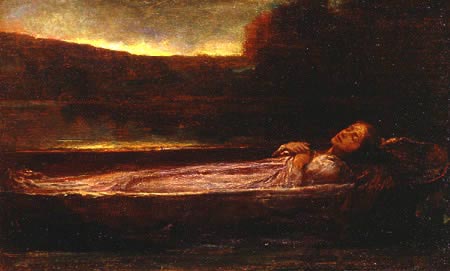
c. 1862. Oil on canvas. 9 x 14 in. (20.48 x 35.84 cm.). Unsigned. The New Britain Museum of American Art (ace. no. 1945.2). Provenance: Kleeman Gallery, New York, 1945; New Britain Museum of American Art.
John La Farge, who was born in New York City in 183 5 to well-to-do French emigrés, received instruction in art at an early age from his grandfather, the minaturist Louis Binsse de Saint-Victor. After studying law for two years, he traveled to Europe in 1856, and while in Paris he studied briefly in Couture's studio. Although La Farge did not decide to become a professional artist until nearly two years after his return from Europe, when he moved to Newport, Rhode Island, to work with William Morris Hunt, his trip abroad greatly influenced the development of his early style. According to the artist himself:
A visit to the Manchester Exhibition and a short stay in England determined for many years certain admirations, and confirmed me in the direction of my ideas of colour. The few pre-Raphaelite paintings that I saw, and the drawings of some of the leaders in that movement, appealed strongly to me ... the pre-Raphaelites, as seen through my eyes — Millais, and Hunt, and Rossetti, and Ford Madox Brown (Sir Edward Burne-Jones had not yet appeared within my horizon) — seemed to me to be willing to meet many of the great problems of colour, and my youthful energies sympathised with the stress and intensity of their dramatic programme. These likings I retained later when I began to think again of painting.'
La Farge's interest in Pre-Raphaelitism was not confined to its formal qualities, for he shared with the Pre-Raphaelites a love for the illustration of poetry. His small oil of The Lady of Shalott is not the only work derived from a work of Tennyson. In 1865 he produced illustrations for an edition of Tennyson's Enoch Arden, published by Ticknor and Fields, Boston, and about the same period he also illustrated works by Browning and Longfellow.
Unlike Holman Hunt, La Farge chose to illustrate an anticlimactic scene from Tennyson's "Lady of Shalott." Accurately depicting the Lady "lying, rob'd in snowey white," La Farge evokes the passage after her death:
A gleaming shape she float'd by,
Dead-pale between the houses high,
Silent into Camelot.
La Farge's fame does not rest solely on his paintings and murals, for he became one of the leading American stained-glass artists of the late-nineteenth century. Com- missions for his windows of fused glass, a technique he first employed in 1880, came from such notables as J. Pierpont Morgan, Cornelius Vanderbik 11, Frederick L. Ames, and Henry Clay Frick. In 1889 his Watson Memorial Window was awarded a medal at the Paris Exposition upon its exhibition there. In the same year, La Farge received the Legion of Honor from the French government. The artist also wrote several essays on art and, in the last two decades of his life, delivered many lectures at the Metropolitan Museum of Art, New York, and the Art Institute of Chicago. La Farge died in Providence, Rhode Island, in 1910, the year of his large retrospective exhibition at the Museum of Fine Arts, Boston.
Bibliography
Neuringer, Miriam. Ladies of Shalott: A Victorian Masterpiece and its Contexts, Ed. George P. Landow. Brown University: 1985. p. 128.
Waern, Cecilia. "John La Farge: Artist and Writer," Portfolio 16 (1896): 3-12.
Created 10 December 2006
Last modified 25 January 2023